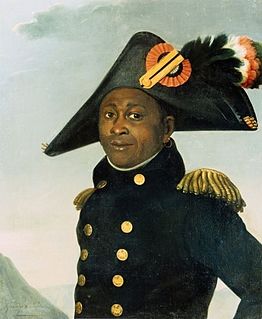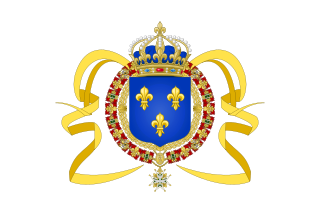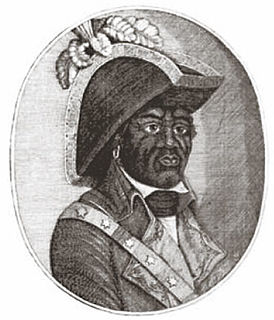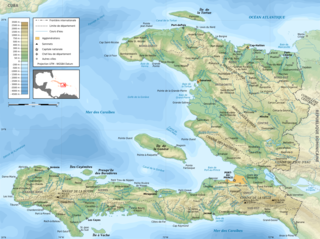
François-Dominique Toussaint Louverture was a Haitian general and the most prominent leader of the Haitian Revolution. During his life, Louverture first fought against the French, then for them, and then finally against France again for the cause of Haitian independence. As a revolutionary leader, Louverture displayed military and political acumen that helped transform the fledgling slave rebellion into a revolutionary movement. Louverture is now known as the "Father of Haiti."

Jean-Jacques Dessalines was a leader of the Haitian Revolution and the first ruler of an independent Haiti under the 1805 constitution. Under Dessalines, Haiti became the first country to permanently abolish slavery. Initially regarded as governor-general, Dessalines was later named Emperor of Haiti as Jacques I (1804–1806) by generals of the Haitian Revolution Army and ruled in that capacity until being assassinated in 1806. He is regarded as being one of the founding fathers of Haiti.

Saint-Domingue was a French colony from 1659 to 1804 on the Caribbean island of Hispaniola; the island that now hosts two countries, the Dominican Republic and Haiti. The name was also used, at times, for the island of Hispaniola as a whole, all of it, nominally, being at times a French colony. The Spanish form of the name, Santo Domingo, also was used at times for the island as a whole. The border between the French-speaking Haiti and the Spanish-speaking Dominican Republic was not established until after the Dominican Republic's declaration of independence in 1844.

In the context of the history of slavery in the Americas, free people of color were people of mixed African, European, and sometimes Native American descent who were not enslaved. They were a distinct group of free people of color in the French colonies, including Louisiana and in settlements on Caribbean islands, such as Saint-Domingue (Haiti), St. Lucia, Dominica, Guadeloupe, and Martinique. In these territories and major cities, particularly New Orleans, and those cities held by the Spanish, a substantial third class of primarily mixed-race, free people developed. These colonial societies classified mixed-race people in a variety of ways, generally related to visible features and to the proportion of African ancestry. Racial classifications were numerous in Latin America.

Médéric Louis Élie Moreau de Saint-Méry, son of Bertrand-Médéric and Marie-Rose Moreau de Saint-Méry, was born in Fort-Royale, Martinique He was a lawyer and writer with a career in public office in France, Martinique, and Saint-Domingue. He is best known for his publications on Saint Domingue and Martinique. He married into a well-positioned family which allowed him to expand his connections among French people and in time, positioned himself as a member of the Parliament of France. Moreau was deeply involved in the founding of the Museum of Paris which he was later appointed president of in 1787

The Haitian Revolution was a successful insurrection by self-liberated slaves against French colonial rule in Saint-Domingue, now the sovereign state of Haiti. The revolt began on 22 August 1791, and ended in 1804 with the former colony's independence. It involved black, biracial, French, Spanish, British, and Polish participants—with the ex-slave Toussaint Louverture emerging as Haiti's most charismatic hero. The revolution was the only slave uprising that led to the founding of a state which was both free from slavery, and ruled by non-whites and former captives. It is now widely seen as a defining moment in the history of the Atlantic World.
Affranchi is a former French legal term denoting a freedman or emancipated slave, but was a term used to refer pejoratively to mulattoes. It is used in the English language to describe the social class of freedmen in Saint-Domingue, and other slave-holding French territories, who held legal rights intermediate between those of free whites and enslaved Africans. In Saint-Domingue, roughly half of the affranchis were gens de couleur libres and the other half African slaves.

François Mackandal was a Haitian Maroon leader in Haiti. He is sometimes described as a Haitian vodou priest, or houngan. For joining Maroons to kill slaves owners in Saint Domingue, he was captured and burned alive by French colonial authorities.

Léger-Félicité Sonthonax was a French abolitionist and Jacobin before joining the Girondist party, which emerged in 1791. During the French Revolution, he controlled 7,000 French troops in Saint-Domingue during part of the Haitian Revolution. His official title was Civil Commissioner. From September 1792 to December 1795, he was the de facto ruler of Saint-Domingue's non-slave populace. Within a year of his appointment, his powers were considerably expanded by the Committee of Public Safety. He was recalled in 1795 largely due to the resurgence of conservative politics in France. Sonthonax believed that Saint-Domingue's whites were royalists or separatists, so he attacked the military power of the white settlers and by doing so alienated the colonial settlers from their government. Many gens de couleur asserted that they could form the military backbone of Saint-Domingue if they were given rights, but Sonthonax rejected this view as outdated in the wake of the August 1791 slave uprising. He believed that Saint-Domingue would need ex-slave soldiers among the ranks of the colonial army if it was to survive. On August 1793, he proclaimed freedom for all slaves in the north province. His critics allege that he was forced into ending slavery in order to maintain his own power.

Georges Biassou was an early leader of the 1791 slave rising in Saint-Domingue that began the Haitian Revolution. With Jean François and Jeannot, he was prophesied by the vodou priest, Dutty Boukman, to lead the revolution.
Julien Raimond (1744–1801) was an indigo planter in the French colony of Saint-Domingue, now the Republic of Haiti, who became a leader in its revolution and the formation of Haiti.

Vincent Ogé was a French aristocrat of mixed descent who instigated a rebellion against white colonial authority in French Saint-Domingue that lasted from October to December 1790 in the area outside Cap-Français, the colony's main city. The Ogé revolt of 1790 foretold the massive slave uprising of August 1791 that eventually led to the Haitian Revolution.
Étienne Polverel (1740–1795) was a French lawyer, aristocrat, and revolutionary. He was a member of the Jacobin club. In 1792, he and Léger Félicité Sonthonax were sent to Saint-Domingue to suppress a slave revolt. Polverel was an abolitionist and after a few years he had emancipated the slaves of the colony and given them political equality.
The Haitian Revolution and the subsequent emancipation of Haiti as an independent state provoked mixed reactions in the United States. Among many white Americans this led to uneasiness, instilling fears of racial instability on its own soil and possible problems with foreign relations and trade between the two countries; among enslaved black Americans it fueled hope that the principles of the recent American Revolution might be realized in their own liberation.
The War of Knives, also known as the War of the South, was a civil war from June 1799 to July 1800 between the Haitian revolutionary Toussaint Louverture, a black ex-slave who controlled the north of Saint-Domingue, and his adversary André Rigaud, a mixed-race free person of color who controlled the south. Louverture and Rigaud fought over de facto control of the French colony of Saint-Domingue during the war. Their conflict followed the withdrawal of British forces from the colony during the early stages of the Haitian Revolution. The war resulted in Toussaint taking control of the entirety of Saint-Domingue, and Rigaud fleeing into exile.

The 1804 Haiti massacre was carried out against the French population and French Creoles remaining in Haiti following the Haitian Revolution, by soldiers, mostly former slaves, under orders from Jean-Jacques Dessalines. He had decreed that all suspected of conspiring in the acts of the expelled army should be put to death. From early January 1804 until 22 April 1804, squads of soldiers moved from house to house throughout Haiti, torturing and killing entire families. Between 3,000 to 5,000 people were killed.

Slavery in Haiti started after the arrival of Christopher Columbus on the island in 1492 with the European colonists that followed from Portugal, Spain and France. The practice was devastating to the native population. Following the indigenous Tainos' near decimation from forced labor, disease and war, the Spanish, under advisement of the Catholic priest Bartolomé de las Casas and with the blessing of the Catholic church, began engaging in earnest in the 1600 kidnapped and forced labor of enslaved Africans. During the French colonial period beginning in 1625, the economy of Haiti was based on slavery, and the practice there was regarded as the most brutal in the world. The Haitian Revolution of 1804, the only successful slave revolt in human history, precipitated the end of slavery not only in Saint-Domingue, but in all French colonies. However, this revolt has only merited a marginal role in the histories of Portuguese and Spanish America. Moreover, it is to this rebellion in Haiti that the struggle for independence in Latin American can be traced to. However, several Haitian leaders following the revolution employed forced labor, believing a plantation-style economy was the only way for Haiti to succeed, and building fortifications to safeguard against attack by the French. During the U.S. occupation between 1915 and 1934, the U.S. military forced Haitians to work building roads for defense against Haitian resistance fighters.
Macaya, was a Kongolese-born Haitian revolutionary military leader. Macaya was one of the first black rebel leaders in Saint-Domingue to ally himself with the French Republican commissioners Sonthonax and Polverel. He helped to lead forces that recaptured Cap-Français on behalf of the French Republicans.

The planter class, known alternatively in the United States as the Southern aristocracy, was a socio-economic caste of Pan-American society that dominated 17th and 18th century agricultural markets through the slavery of African Americans. The Atlantic slave trade permitted planters access to inexpensive labor for the planting and harvesting of crops such as tobacco, cotton, indigo, coffee, tea, cocoa, sugar cane, sisal, oil seeds, oil palms, hemp, rubber trees, and fruits. Planters were considered part of the American gentry.
Alexandre de Vincent de Mazade was a French soldier who was twice acting governor of the French colony of Saint-Domingue between 1787 and 1789.














